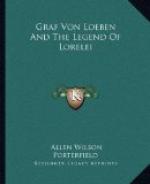But be his poems never so good, there is no reason why Loeben should be revived for the general reader. His prose works lack artistic measure and objective plausibility; his lyrics lack clarity and virility; his creations in general lack the story-telling property that holds attention and the human-interest touches that move the soul. His thirty-nine years were too empty of real experience;[27] his works are not filled with the matter that endures. And it is for this reason that they ceased to live after their author had died. His connection with this earth was always just at the snapping-point. His works constitute, in many instances, a poetic rearrangement of what he had just latterly read. And when he is original he is vacuous. To emphasize his works for their own sake would consequently be to set up false values. Loeben can be studied with profit only by those people who believe that great poets can be better understood and appreciated by a study of the literary than by a study of the economic background. To know Loeben[28] throws light on some of his much greater contemporaries—Goethe, Eichendorff, Kleist, Novalis, Arnim, Brentano, Uhland, GOerres, Tieck, and possibly Heine.
II
But it is not so much the purpose of this paper to evaluate Loeben’s creations as to locate him in the development of the Lorelei-legend, and to prove, or disprove, Heine’s indebtedness to him in the case of his own poem of like name. The facts are these:
In 1801 Clemens Brentano published at Bremen the first volume of his __Godwi_ and in 1802 the second volume at the same place.[29] He had finished the novel early in 1799—he was then twenty-one years old. Wieland was instrumental in securing a publisher.[30] Near the close of the second volume, Violette sings the song beginning:
Zu Bacharach am Rheine
Wohnt eine Zauberin.
That this now well-known ballad of the Lorelei was invented by Brentano is proved, not so much by his own statement to that effect as by the fact that the erudite and diligent Grimm brothers, the friends of Brentano, did not include the Lorelei-legend in their collection of 579 Deutsche Sagen, 1816. The name of his heroine Brentano took from the famous echo-rock near St. Goar, with which locality he became thoroughly familiar during the years 1780-89. No romanticist knew the Rhine better or loved it more than Brentano. “Lore” means[31] a




